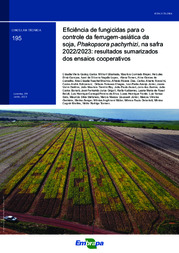Excess rainfall can favor early incidence of soybean rust
Excess rainfall can favor early incidence of soybean rust
The higher rainfall in the Brazilian South due to the influence of the El Niño phenomenon can be conducive to soybean diseases like Asian rust, caused by the fungus Phakopsora pachyrhizi. "This crop year (2023/2024), there have already been reports of volunteer soybean plants (which germinate from grains that are lost at harvest) and perennial soybeans (non-commercial soybeans) with symptoms of the disease. Therefore, farmers should keep alert to a possible early incidence of the disease in commercial areas in the South of Brazil”, warns researcher Cláudia Godoy, from Embrapa Soybeans.
According to Godoy, the excess rainfall in the South at the beginning of the crop season can also cause problems like lodging and death of newly germinated plants (seedlings), especially in soils with low drainage. On the other hand, the lack of rainfall in the Midwest can compromise germination and initial plant development.
The researcher explains that the spores of the fungus that causes rust spread easily with the wind and thus, when their presence in the region is identified, control should be initiated preventively or at the first symptoms. “Monitoring and quick action against the disease will ensure higher efficiency in control. In that sense, delays in applications increase the possibilities of control failure," Godoy warns.
In addition, the researcher assesses that in late sowing, the disease will tend to be more severe due to the increased presence of the fungus in the air. Another aspect that draws the researcher's attention is the growing difficulty in controlling Asian rust due to the lower sensitivity of the fungus to fungicides. The site-specific fungicides that control the disease belong to three distinct groups: demethylation inhibitors (DMIs, “triazoles”), quinone outside inhibitors (QoIs, “strobins”), and succinate dehydrogenase inhibitors (SDHIs, “carboxamides”).
"A new mutation in the fungus has recently been reported, influencing the efficiency of fungicides that have the active ingredients prothioconazole and tebuconazole (triazoles) in their composition," she explains. "The guideline is that fungicides with these active ingredients are used in rotation and always with the addition of multisite fungicides - those that interfere with many of the fungus' metabolic processes - to increase control efficiency," she explains.
Detailed information on the efficiencies of fungicides is available in the publication “Eficiência de fungicidas para o controle da ferrugem-asiática da soja, Phakopsora pachyrhizi, na safra 2022/2023: Resultados sumarizados dos ensaios cooperativos (Circular Técnica 195) [Efficiency of fungicides for the control of Asian soybean rust, Phakopsora pachyrhizi, in the 2022/2023 crop year: Summarized findings of cooperative trials (Technical Circular 195)].
About Asian rust
Asian rust is the most severe disease in soybean crops, and it can cause losses of up to 90% of the yield if left unchecked. "In addition to control with fungicides, the adoption of sanitary breaks and early sowing are the main strategies to have farmers evade the disease, as there are less fungal spores in the initial sowing," Godoy states.
During the crop year, information about the occurrence of rust can be followed on the Anti-Rust Consortium's website or on an app available for download from the Apple Store or Google Play. In the state of Paraná, the occurrence of Asian rust spores in collectors can be monitored on the website for the Rural Development Institute of Paraná (IDR-Paraná).
Lebna Landgraf (MTb 2903 - PR)
Embrapa Soybeans
Press inquiries
soja.imprensa@embrapa.br
Phone number: +55 43 3371-6061 (whatsapp)
Translation: Mariana Medeiros (13044/DF)
Superintendency of Communications
Further information on the topic
Citizen Attention Service (SAC)
www.embrapa.br/contact-us/sac/


